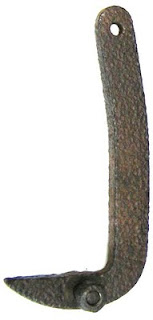 |
| Grubby looking thing! |
 |
| Alternative view |
 |
| With mounting flange and whistle-mounting elbow |
 |
| Whistle valve roof-mounted in Isebrook |
 |
| Whistle valve roof-mounted in William |
 |
| Front-mounted whistle (the valve is inside) |
 |
| Functional Parts |
 |
| Conical valve (not to scale!) |
 |
| Valve seat inside end of valve body |
 |
| Spring and retainer which screws into the end of the valve body |
 |
| Rod (not much more to say on this!) |
 |
| Operating lever |
The steam pressure holds the conical valve in place until the lever is used to push it open. This is a sudden action which is also terminated abruptly by the steam forcing the conical valve shut again. Hence the whistle valve enables a quick 'pop' to be achieved as well as the long 'poop'!
There is one more aperture in the valve body shown with a copper tube attached in the Isebrook valve picture (but, oddly, not on William).
 |
| Condensate drain |
When it's all assembled, it looks like this.
 |
| Note the elegant MDF cab front substitute and supporting clothes' peg! |
No comments:
Post a Comment